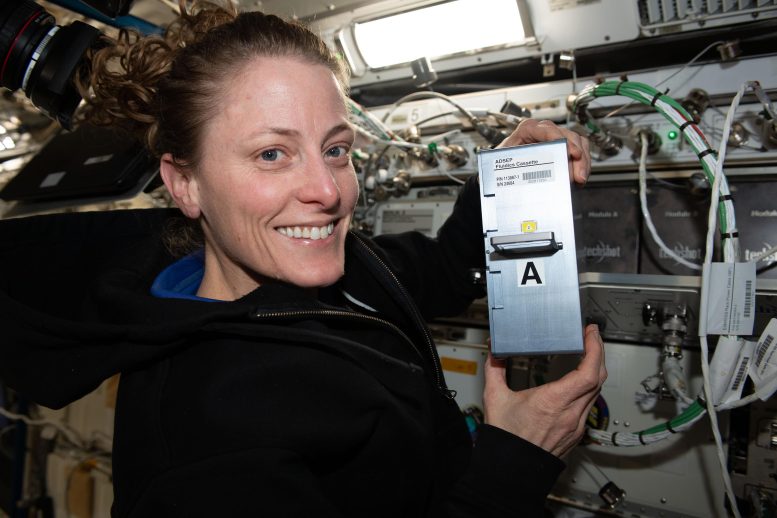
NASA astronaut and Expedition 70 Flight Engineer Loral O’Hara shows off research hardware supporting the UMAMI, or Understanding of Microgravity on Animal-Microbe Interaction, space biology experiment. O’Hara is holding the Advanced Space Experiment Processor (ADSEP) Fluid Processing Cassette (FPC) that supports the observation of the effects of spaceflight on the molecular and chemical interactions between beneficial microbes and their animal hosts. Credit: NASA
The Expedition 70 crew continues packing the SpaceX Dragon cargo spacecraft while also keeping up microgravity research for NASA and its partners to advance humanity on Earth and in space.
NASA and SpaceX are postponing the Friday, December 15, undocking of a SpaceX Dragon cargo resupply spacecraft from the International Space Station (ISS) due to unfavorable weather conditions as a result of a cold front passing through the splashdown zones off the coast of Florida.
Joint teams continue to evaluate weather conditions to determine the best opportunity for Dragon to autonomously undock from the space station with the next available opportunity no earlier than 5:05 p.m. EST Saturday, December 16.
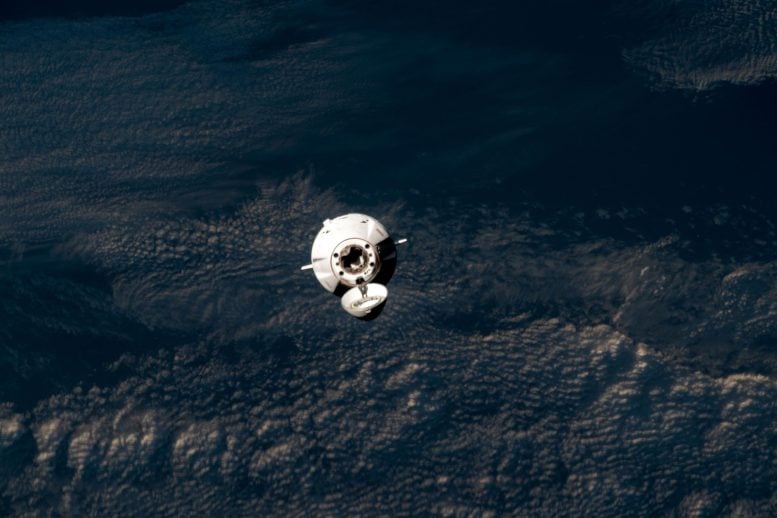
The SpaceX Dragon cargo craft approaches the International Space Station for an automated docking. Both spacecraft were orbiting 259 miles above the Pacific Ocean off the coast of Japan at the time of this photograph from the orbital outpost. Credit: NASA
Weather permitting for the Saturday undocking, coverage of Dragon’s departure will begin at 4:45 p.m. on the NASA+ streaming service via the web or the NASA app. Coverage also will air live on NASA Television, YouTube, and on the agency’s website. Learn how to stream NASA TV through a variety of platforms including social media.
After re-entering Earth’s atmosphere, the spacecraft will splash down off the coast of Florida, which will not be broadcast on NASA TV. Follow updates on return plans on the agency’s space station blog.
Astronauts Jasmin Moghbeli of NASA and Satoshi Furukawa of JAXA (Japan Aerospace Exploration Agency) continued securing bags packed with return cargo and discarded items inside Dragon for the undocking and return to Earth’s gravity. Moghbeli also joined NASA astronaut Loral O’Hara and tended to biological samples on the station that will soon be stowed aboard Dragon.
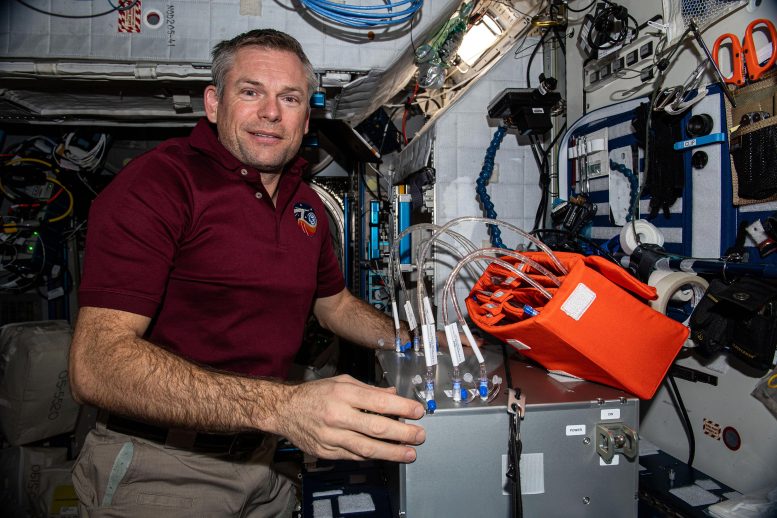
ESA (European Space Agency) astronaut and Expedition 70 Commander Andreas Mogensen works on the Aquamembrane-3 technology demonstration in the International Space Station’s Harmony module. The investigation explores the contaminant rejection and water transport capabilities of advanced life support equipment that may benefit future space missions and reduce water scarcity in arid conditions on Earth. Credit: NASA
Commander Andreas Mogensen of ESA (European Space Agency) turned his attention to the Northrop Grumman Cygnus spacecraft scheduled to depart later this month. Moghbeli joined Mogensen readying the private cargo craft for its robotic detachment from the Unity module and release back into Earth orbit for descent.
Meanwhile, a wide array of space science to improve life for astronauts in space and people on Earth is ongoing aboard the orbiting lab. The seven space station residents explored how weightlessness affects plant life, robotics, and more.
O’Hara worked in the Kibo laboratory module adding water to the Advanced Plant Habitat to prepare for an upcoming experiment observing how microgravity affects a plant’s immunity system. Furukawa configured a pair of toaster-sized, Astrobee robotic free-flyers and tested their ability to autonomously dock with each other.
Cosmonauts Oleg Kononenko and Nikolai Chub joined each other at the beginning of their shift and took turns pedaling on an exercise cycle. The Roscosmos flight engineers assisted each other attached electrodes to each other and collected blood pressure measurements during the periodic physical fitness evaluation. Flight Engineer Konstantin Borisov also participated in the exercise test at the end of his shift.
Kononenko later joined Borisov in the afternoon checking an incubator and a centrifuge holding egg samples for a space biology study. Chub wrapped up his day working on the Elektron oxygen generator and changing out smoke detectors.
Axiom Space has announced the launch date for its third private astronaut mission to the station no earlier than January 9, from Florida. Commander Michael Lopez-Alegria will lead Pilot Walter Villadei and Mission Specialists Alper Gezeravci and Marcus Wandt aboard the SpaceX Dragon spacecraft and stay aboard the orbital outpost for a two-week research mission.


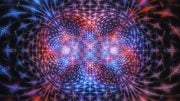






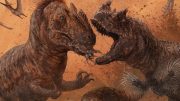
First to say that in my life I have found in employment experiences several different ways to improve the processes of assembling difficult engineering collective outcomes and preperationale pathways that improved a result of problem areas in manufacturing and procedures to a result in several successful improvements, none of which I was recognised as being the pivalate influence, a signed contract that any improvements were the property of my employer. That being stated I feel compelled to offer a experiment of the problem area of effect in resolving weightless degradation to a human body in space, a comparison of one human to others after spending a lengthy time in weightless space. A designed clothing of spandex material body suit that is worn in space creating a artificial pressure of atmospheric pressure of gravity, the suit somewhat like a wetsuit coverage of the body that holds a force equal to earth bound gravity pressure, the suit would have to be sized for each different individual using a mathematical formula of tension in the spandex and reduce the size so when entering a weightless environment and applying the suit the tension of compression would memic gravitational pressure, minimise as much possible of skin area exposed to the weightless environment. After time in space a comparison of the individual to crew members could be analyzed to any improvements over loose fitting clothing.